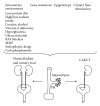Congenital anomalies of the kidney and urinary tract: a genetic disorder?
- PMID: 22685656
- PMCID: PMC3363415
- DOI: 10.1155/2012/909083
Congenital anomalies of the kidney and urinary tract: a genetic disorder?
Abstract
Congenital anomalies of the kidney and urinary tract (CAKUTs) occur in 3-6 per 1000 live births, account for the most cases of pediatric end-stage kidney disease (ESKD), and predispose an individual to hypertension and cardiovascular disease throughout life. Although CAKUTs are a part of many known syndromes, only few single-candidate causative genes have been implicated so far in nonsyndromic cases of human CAKUT. Evidence from mouse models supports the hypothesis that non-syndromic human CAKUT may be caused by single-gene defects. Because increasing numbers of children with CAKUT are surviving to adulthood, better understanding of the molecular pathogenesis of CAKUT, development of new strategies aiming at prevention of CAKUT, preservation of renal function, and avoidance of associated cardiovascular morbidity are needed. In this paper, we will focus on the knowledge derived from the study of syndromic and non-syndromic forms of CAKUT in humans and mouse mutants to discuss the role of genetic, epigenetic, and in utero environmental factors in the pathogenesis of non-syndromic forms of CAKUT in children with particular emphasis on the genetic contributions to CAKUT.
Figures

References
-
- Daneman A, Alton DJ. Radiographic manifestations of renal anomalies. Radiologic Clinics of North America . 1991;29(2):351–363. . - PubMed
-
- Nakanishi K, Yoshikawa N. Genetic disorders of human congenital anomalies of the kidney and urinary tract (CAKUT) Pediatrics International . 2003;45(5):610–616. . - PubMed
-
- North American Pediatric Renal Trials and Collaborative Studies, NAPRTCS Annual report, 2010 https://web.emmes.com/study/ped/annlrept/2010_Report.pdf .
-
- ESPN/ERA-EDTA Registry UK Renal Registry. annual report, 2008, http://www.espn-reg.org/
-
- Ardissino G, Daccò V, Testa S, et al. Epidemiology of chronic renal failure in children: data from the ItalKid project. Pediatrics . 2003;111(4, part 1):e382–e387. . - PubMed
LinkOut - more resources
Full Text Sources

